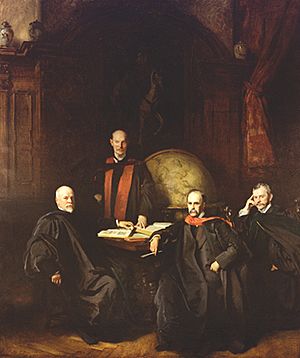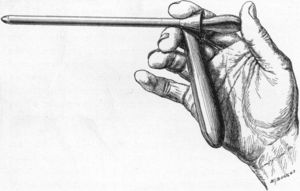Howard Atwood Kelly facts for kids
Quick facts for kids
Howard A. Kelly
|
|
|---|---|
 |
|
| Born | February 20, 1858 Camden, New Jersey, U.S.
|
| Died | January 12, 1943 (aged 84) |
| Nationality | American |
| Alma mater | University of Pennsylvania (BA,MD) |
| Occupation | |
| Relatives | Dora Lewis (sister) |
| Signature | |
Howard Atwood Kelly (born February 20, 1858 – died January 12, 1943) was an American doctor. He specialized in women's health. He earned his college and medical degrees from the University of Pennsylvania.
He was one of the "Big Four" founding professors. These four doctors helped start the famous Johns Hopkins Hospital in Baltimore, Maryland. Kelly is known for making gynecology a special field of medicine. He created new ways to perform surgery for women's diseases. He also did important research on diseases.
Kelly also invented several medical tools. These include an improved cystoscope, Kelly's clamp, Kelly's speculum, and Kelly's forceps. Some people questioned his medical work because he was a strong supporter of Prohibition and a Fundamentalist Christian.
Contents
Early Life and Education
Howard Kelly was born in Camden, New Jersey, in 1858. His parents were Henry Kuhl Kelly and Louisa Warner (Hard) Kelly. His family had a history in politics and business. Kelly grew up with strong religious beliefs. His mother especially influenced him.
During the American Civil War, Kelly and his mother lived in Chester, Pennsylvania. His father was serving in the war. Kelly spent his free time observing nature and studying the Bible with his mother. In 1867, Kelly started at the Faires Classical Institute. There, he became interested in languages, biology, natural science, and botany.
In 1873, he began his college education at the University of Pennsylvania. During college, he led the Franklin Scientific Society. At 17, he joined the Philadelphia Academy of Natural Sciences. He received his college degree in 1877.
Medical Career
Becoming a Doctor
In 1877, Kelly enrolled in medical school at the University of Pennsylvania. He became very interested in how the body is built. In 1882, he graduated with a special award for his work in anatomy. He then did his residency at the Episcopal Hospital in Kensington, Philadelphia.
Since the hospital did not focus on women's health, Kelly opened his own clinic. It was in a two-story house in a working neighborhood. He lived there too. He saw patients during the day. At night, he slept on a sofa with a string tied to his toe. If someone needed help, they would tug the string to wake him. He also visited patients at their homes.
Later, with money from women who supported good causes, he opened a proper clinic. It had an operating room in Norris Square. This clinic later became the Kensington Hospital for Women. It was the sixth women's hospital in the United States. There, he created the "Kelly stitch." This procedure helped treat bladder control problems. He also performed the first successful C-section in Philadelphia. He became known for his new surgical methods.
From 1886 to 1888, Kelly traveled to Europe. He visited England, Scotland, and Germany. He watched many abdominal and pelvic surgeons at work. In 1886, in Leipzig, he learned how to feel a woman's ureters (tubes from the kidneys to the bladder). In Berlin in 1888, he worked with a pathologist named Rudolf Virchow. They studied the best way to use a catheter in ureters. Then, in Prague in 1888, a Czech doctor named Parel Pawlik showed him how to use a speculum to catheterize ureters. He also learned how to do an air cystoscopy. In 1888, he returned to the University of Pennsylvania. He became an associate professor of childbirth.
Working at Johns Hopkins
In 1889, Dr. William Osler asked Kelly to lead the gynecological surgery department. This was at the Johns Hopkins School of Medicine. Kelly, Osler, William Stewart Halsted, and William H. Welch became known as "The Big Four." They were the main founding doctors at Hopkins.
Three years later, Kelly started the Howard A. Kelly Hospital in Baltimore. It stayed open until 1938. Kelly did not charge patients for surgeries at Hopkins. However, he charged a lot for his private medical services.
Important Medical Discoveries
In the early 1890s, Kelly focused on bladder and reproductive health. He is famous for making gynecology its own special medical field. His textbook, Operative Gynecology, created a clear way to approach women's medicine and surgery.
Besides "Kelly's stitch," he developed other new surgical methods and tools.
He found what is called "Kelly's sign." This helps surgeons find the ureter during operations. Ureters can sometimes stick to other tissues. Kelly's sign is a way to gently press the ureter. This causes a worm-like muscle movement called peristalsis. This movement helps doctors find the ureter.
Kelly also created better ways to examine the bladder. He improved on methods he learned from Pawlik.
He also invented "Kelly's forceps" or "Kelly's Clamp." These are curved tools that look like scissors. But instead of sharp blades, they have blunt grips. They are used to clamp blood vessels. This helps control blood flow during surgery. These forceps are some of the most common surgical tools.
To make surgery safer, Kelly used nitrous oxide for pain relief. He also used stitches that dissolve in the body. He used electric lights for better visibility during surgery. He was one of the first surgeons to use an operating suit. This was special clothing made of sterilized fabric. To prevent infections, he also invented a way to seal wounds. He would soak two layers of sterilized gauze with special liquids. This secured the dressing to the skin. Then, he would dust the surface with powders. The wound was not exposed until the stitches were removed.
In the late 1890s, Kelly became interested in cancers affecting women. To reduce bleeding from cervical and uterine cancers, he tied off a certain artery. This technique is now used for heavy bleeding after childbirth.

Kelly also experimented with Radium in 1904. He used radium to treat heavy uterine bleeding and fibroid tumors. He published his findings in a medical journal in 1914. Newspaper articles from 1914 describe Kelly's visit to zircon mines in Zirconia, North Carolina. He was looking for radium sources. In 1917, his clinic had about 5.5 grams of radium. It was one of the top centers for radiation treatment for cancer at that time.
Medical Illustrations
While writing his book Operative Gynecology, Kelly worked with Max Brödel. Brödel is known as the father of medical illustration. Broedel watched Kelly during surgeries. He also took special 3D photographs called "Stereo Clinics." These were published in the textbook. Kelly said that bringing Broedel to Baltimore was one of his greatest contributions to medicine. Kelly encouraged Broedel to do his own research. He often gave him more time for his illustrations. Later, he also invited Hermann Becker and August Horm to join the illustration team.
Teacher and Writer
Kelly not only changed surgery but also how medicine was taught. He felt that his own training was too strict. So, he encouraged his interns to try new things. He also told them to travel abroad and observe other doctors. He even helped some of his assistants publish their work.
He did not like teaching by lecturing to large groups. He felt students could not see much during operations in a big amphitheater. Instead, he taught small groups of students. They would be present while he saw and operated on patients.
By the end of his career, Kelly had written over 550 articles and books. These covered topics like appendix removal, the use of radium, electric surgery, urogynecology, and ureteral catheterization. He also wrote about medical history, religion, stars, rocks, religious studies, reptiles and amphibians, and botany.
Personal Life
Family Life
In 1889, Kelly married Olga Elizabeth Laetitia Bredow in Danzig, Germany. She was the daughter of Doctor Justus Bredow. They spent their first trip together in Paris, France. In Baltimore, they raised nine children. They lived in a large home with a library of 100,000 books. Kelly raised his children with strong religious beliefs, just as he was raised. One of his sons, Edmund Kelly, also became a doctor.
Love for Nature
Kelly's childhood interest in nature continued throughout his life. He kept many cages filled with different types of reptiles in his house. He even learned how to handle rattlesnakes and collect their poison. Later, Kelly was named an Honorary Curator by the Division of Reptiles and Amphibians at the University of Michigan.
He also studied fungi, including how to identify mushrooms. He collected many different fungi and kept lists of species. In 1924, with help from Louis Krieger, he published a catalog of his fungi collection. It had over 400,000 entries, artworks, 7,000 book titles on mushrooms, and models of fungi. In 1928, Kelly gave his collection to the Herbarium of the University of Michigan. This collection is now called The L. C. C. Krieger Mycological Library and Collections.
He also collected coins, mineral samples, Mexican pottery, oil lamps, and even some shrunken heads.
He also owned a log cabin on the Ahmic Lake. It had its own library, microscopes, and binoculars. There was a seating area on the roof where he used a telescope to watch the stars.
Religious Beliefs
Kelly was very dedicated to his Episcopal faith. His religious life began with his mother teaching him about the Bible. As a teenager, Kelly read the Bible in its original Greek and Hebrew languages. He even gave out New Testament scriptures to his friends. This showed his early efforts to share his faith. As an adult, Kelly observed the Sabbath, read the Bible daily, and wrote books about religion. One of his books was A Scientific Man and the Bible.
At the hospital, Kelly held prayer meetings before every operation. At home, he gave long sermons to his family after Sunday dinners. Kelly also prepared sermons for different churches when their ministers were not available. He also supported missionaries.
A writer from Baltimore, H. L. Mencken, sometimes made fun of Kelly's strong religious devotion. Mencken once wrote that Kelly would wake up early, pray, read the Bible, sing hymns, perform many surgeries, and then rush off to raid a gambling house. This was a humorous way to describe Kelly's busy and religious life.
Death
Howard Kelly and his wife died about six hours apart. They passed away at Union Memorial Hospital on January 12, 1943. Kelly was 84 years old. Their joint funeral was held at the Memorial Episcopal Church. They were buried at Woodlawn Cemetery, both in Baltimore.
Recognition and Honors
Some of Howard Kelly's awards and honors include:
- An honorary Doctor of Laws degree from the University of Pennsylvania in 1907.
- Named an honorary fellow by universities in many cities, including Edinburgh, Glasgow, Dublin, London, Paris, Rome, Berlin, and Vienna.
- A founding member of the American College of Surgeons in 1913.
- Named Honorary Curator by the Division of Reptiles and Amphibians at the University of Michigan Museum of Zoology.
- The Johns Hopkins Kelly Gynecologic Oncology Service is named after him.
- In 1943, a U.S. Liberty ship was named the Howard A. Kelly.
- The Howard A. Kelly Alumni Society was created to honor him. It was formed by doctors and alumni of the Johns Hopkins Gynecology and Obstetrics Department.
- Awarded the Order of Leopold (Belgium), the Order of the Cross of Mercy, Serbia, and the Cross of Charity.
See also
 This article incorporates text from a publication now in the public domain: "Kelly, Howard Atwood". New International Encyclopedia 11. (1905).
This article incorporates text from a publication now in the public domain: "Kelly, Howard Atwood". New International Encyclopedia 11. (1905).




